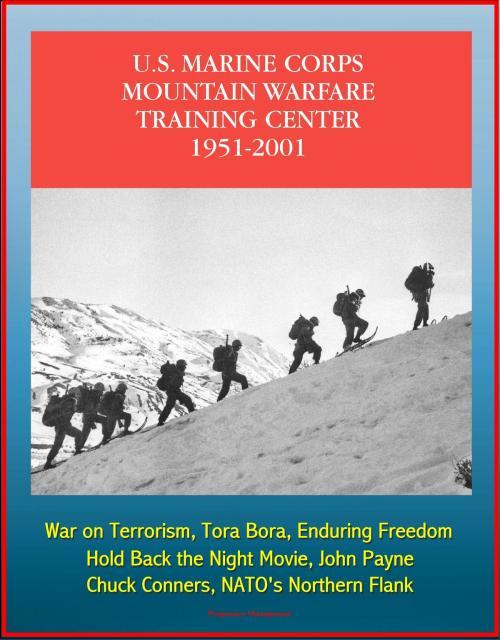The U.S. Marine Corps Mountain Warfare Training Center 1951-2001: Sierra Nevada Range, Cold Weather, Pickel Meadow, Hold Back the Night Movie, John Payne, Chuck Conners, NATO's Northern Flank
Nonfiction, History, Military, United States| Author: | Progressive Management | ISBN: | 9781301282777 |
| Publisher: | Progressive Management | Publication: | December 11, 2012 |
| Imprint: | Smashwords Edition | Language: | English |
| Author: | Progressive Management |
| ISBN: | 9781301282777 |
| Publisher: | Progressive Management |
| Publication: | December 11, 2012 |
| Imprint: | Smashwords Edition |
| Language: | English |
The following account represents a significant look at a half century of U.S. Marine Corps effort in the Sierra Nevada mountain range of California. This has been and is still the location of the Corps cold weather and mountain training facility. Over time the needs and demands for Marines and units prepared to operate under these conditions waxed and waned with the real world requirements of deployed forces. This was reflected in the realities of conflicts in the Korean Peninsula, the Cold War's northern and southern flanks, and in the current Global War in Terrorism fight in Afghanistan and elsewhere. While the future is often uncertain, this firm look at the past is useful to show how previous challenges have prompted creative and innovative responses. This is as much a story of evolution as an institution.
This is the story of the Marine Corps Mountain Warfare Training Center. MCMWTC was established due to lessons learned from the legendary Chosin Reservoir Campaign in North Korea during the winter of 19501951. Experiences there showed a pressing need for a training program to prepare Marines for the rigors of harsh winter combat. What started as a basic cold-weather indoctrination program for the replacement drafts bound for Korea evolved over time into a year-round training facility that is one-of-a-kind for the entire Department of Defense.
Chapter 1: The Sierra Nevada Range * The Mountains * The Indians * Colonizers and Trappers * Fremont and the Lost Cannon * Emigrants and Argonauts * Chapter 2: U.S. Marine Corps Cold Weather Experience and Doctrine Prior to 1950 * Introduction * Special Duty in the Bering Sea * Expedition to Iceland * Between World War II and Korea * Chapter 3: The Marines Arrive * Korean War Backdrop * "All personnel . . . would be thoroughly indoctrinated" * "Take what action is necessary to establish a suitable training site" * Activation of the Cold Weather Battalion * Chapter 4: Cold Weather Battalion's First Year * "We've got to get 'em tougher to survive" * The Winter of 1951-1952 * Chapter 5: Making Improvements, 1952-1956 * Introduction * Facilities * Organization for Training * Cold-Weather Clothing Equipment * Command Relationships * Building a Camp, 1952 * Cease-Fire in Korea * Chapter 6: Expanding the Mission, 1957-1958 * Introduction * Changes to Command Relationships * Organization for Meeting the New Training Mission * Evasion, Escape, and Survival Course * Mountain Leadership Course * Unit Training * Chapter 7: Winners Never Quit, 1958-1961 * Introduction * "Zum Gipfel" * 1960 Winter Olympic Games * A Change in the Watch * Chapter 8: Mountain Men, 1962-1965 * Marines Who Proved a Match for the Mountains * Shifts in the Wind * Chapter 9: In the Doldrums, 1966-1979 * Vietnam War Backdrop * MWTC on the Slippery Slope * Deactivation and Caretaker Status * Use it or Lose it! * Reactivation of the Mountain Warfare Training Center * Chapter 10: NATO's Northern Flank: A New Imperative, 1979-1983 * Strategic Background: From Benign Neglect to Heightened Awareness * Costs and Risks of the New Initiative * 1981: Year of Decision * Laying the Foundation for Improvements * Chapter 11: Ascending New Heights, 1984-1990 * Rebuilding MWTC and Expanding its Capabilities * Improvements in Cold-Weather Clothing and Equipment * Land Prepositioning in Norway * Picking up the Pace in Operations and Modernization of the Training Center * Reaching the High Water Mark * Chapter 12: The 1990s: A Post-Cold War World * Introduction * Continuing Operations while dealing with Future Uncertainties * Demonstrating MWTC value During Peacetime * Golden Anniversary * Epilogue * Strategic Backdrop * Mountain Warfare Training Center Shifts with the Tides of War * Debates over Deployment * A Strategic Vision for Mountain Warfare Training Center's Second Half-Century
The following account represents a significant look at a half century of U.S. Marine Corps effort in the Sierra Nevada mountain range of California. This has been and is still the location of the Corps cold weather and mountain training facility. Over time the needs and demands for Marines and units prepared to operate under these conditions waxed and waned with the real world requirements of deployed forces. This was reflected in the realities of conflicts in the Korean Peninsula, the Cold War's northern and southern flanks, and in the current Global War in Terrorism fight in Afghanistan and elsewhere. While the future is often uncertain, this firm look at the past is useful to show how previous challenges have prompted creative and innovative responses. This is as much a story of evolution as an institution.
This is the story of the Marine Corps Mountain Warfare Training Center. MCMWTC was established due to lessons learned from the legendary Chosin Reservoir Campaign in North Korea during the winter of 19501951. Experiences there showed a pressing need for a training program to prepare Marines for the rigors of harsh winter combat. What started as a basic cold-weather indoctrination program for the replacement drafts bound for Korea evolved over time into a year-round training facility that is one-of-a-kind for the entire Department of Defense.
Chapter 1: The Sierra Nevada Range * The Mountains * The Indians * Colonizers and Trappers * Fremont and the Lost Cannon * Emigrants and Argonauts * Chapter 2: U.S. Marine Corps Cold Weather Experience and Doctrine Prior to 1950 * Introduction * Special Duty in the Bering Sea * Expedition to Iceland * Between World War II and Korea * Chapter 3: The Marines Arrive * Korean War Backdrop * "All personnel . . . would be thoroughly indoctrinated" * "Take what action is necessary to establish a suitable training site" * Activation of the Cold Weather Battalion * Chapter 4: Cold Weather Battalion's First Year * "We've got to get 'em tougher to survive" * The Winter of 1951-1952 * Chapter 5: Making Improvements, 1952-1956 * Introduction * Facilities * Organization for Training * Cold-Weather Clothing Equipment * Command Relationships * Building a Camp, 1952 * Cease-Fire in Korea * Chapter 6: Expanding the Mission, 1957-1958 * Introduction * Changes to Command Relationships * Organization for Meeting the New Training Mission * Evasion, Escape, and Survival Course * Mountain Leadership Course * Unit Training * Chapter 7: Winners Never Quit, 1958-1961 * Introduction * "Zum Gipfel" * 1960 Winter Olympic Games * A Change in the Watch * Chapter 8: Mountain Men, 1962-1965 * Marines Who Proved a Match for the Mountains * Shifts in the Wind * Chapter 9: In the Doldrums, 1966-1979 * Vietnam War Backdrop * MWTC on the Slippery Slope * Deactivation and Caretaker Status * Use it or Lose it! * Reactivation of the Mountain Warfare Training Center * Chapter 10: NATO's Northern Flank: A New Imperative, 1979-1983 * Strategic Background: From Benign Neglect to Heightened Awareness * Costs and Risks of the New Initiative * 1981: Year of Decision * Laying the Foundation for Improvements * Chapter 11: Ascending New Heights, 1984-1990 * Rebuilding MWTC and Expanding its Capabilities * Improvements in Cold-Weather Clothing and Equipment * Land Prepositioning in Norway * Picking up the Pace in Operations and Modernization of the Training Center * Reaching the High Water Mark * Chapter 12: The 1990s: A Post-Cold War World * Introduction * Continuing Operations while dealing with Future Uncertainties * Demonstrating MWTC value During Peacetime * Golden Anniversary * Epilogue * Strategic Backdrop * Mountain Warfare Training Center Shifts with the Tides of War * Debates over Deployment * A Strategic Vision for Mountain Warfare Training Center's Second Half-Century















